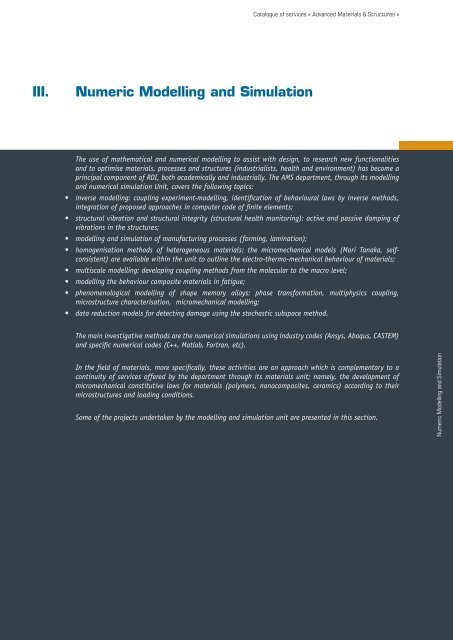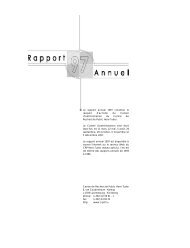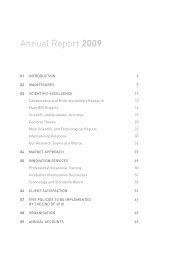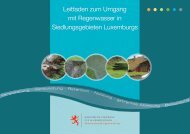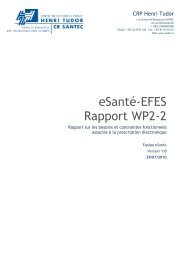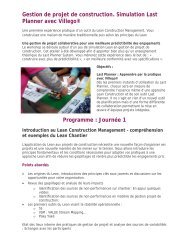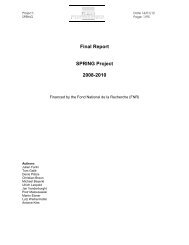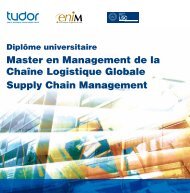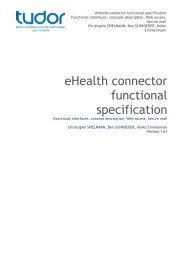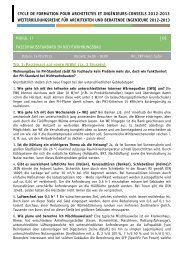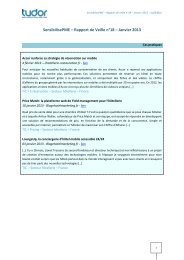III. Numeric Modelling and Simulation - CRP Henri Tudor
III. Numeric Modelling and Simulation - CRP Henri Tudor
III. Numeric Modelling and Simulation - CRP Henri Tudor
Create successful ePaper yourself
Turn your PDF publications into a flip-book with our unique Google optimized e-Paper software.
Catalogue of services « Advanced Materials & Structures »<br />
<strong>III</strong>.<br />
<strong>Numeric</strong> <strong>Modelling</strong> <strong>and</strong> <strong>Simulation</strong><br />
The use of mathematical <strong>and</strong> numerical modelling to assist with design, to research new functionalities<br />
<strong>and</strong> to optimise materials, processes <strong>and</strong> structures (industrialists, health <strong>and</strong> environment) has become a<br />
principal component of RDI, both academically <strong>and</strong> industrially. The AMS department, through its modelling<br />
<strong>and</strong> numerical simulation Unit, covers the following topics:<br />
• inverse modelling: coupling experiment-modelling, identification of behavioural laws by inverse methods,<br />
integration of proposed approaches in computer code of finite elements;<br />
• structural vibration <strong>and</strong> structural integrity (structural health monitoring): active <strong>and</strong> passive damping of<br />
vibrations in the structures;<br />
• modelling <strong>and</strong> simulation of manufacturing processes (forming, lamination);<br />
• homogenisation methods of heterogeneous materials: the micromechanical models (Mori Tanaka, selfconsistent)<br />
are available within the unit to outline the electro-thermo-mechanical behaviour of materials;<br />
• multiscale modelling: developing coupling methods from the molecular to the macro level;<br />
• modelling the behaviour composite materials in fatigue;<br />
• phenomenological modelling of shape memory alloys: phase transformation, multiphysics coupling,<br />
microstructure characterisation, micromechanical modelling;<br />
• data reduction models for detecting damage using the stochastic subspace method.<br />
The main investigative methods are the numerical simulations using industry codes (Ansys, Abaqus, CASTEM)<br />
<strong>and</strong> specific numerical codes (C++, Matlab, Fortran, etc).<br />
In the field of materials, more specifically, these activities are an approach which is complementary to a<br />
continuity of services offered by the department through its materials unit; namely, the development of<br />
micromechanical constitutive laws for materials (polymers, nanocomposites, ceramics) according to their<br />
microstructures <strong>and</strong> loading conditions.<br />
Some of the projects undertaken by the modelling <strong>and</strong> simulation unit are presented in this section.<br />
<strong>Numeric</strong> <strong>Modelling</strong> <strong>and</strong> <strong>Simulation</strong>
<strong>III</strong>.1.<br />
Improve material performances <strong>and</strong> engineering<br />
design cycle using simulations <strong>and</strong> computational<br />
tools<br />
<strong>Modelling</strong> <strong>and</strong> <strong>Simulation</strong> Services at the Centre de Recherche Public <strong>Henri</strong> <strong>Tudor</strong> are devoted to the development<br />
of new methodologies <strong>and</strong> simulation tools for supporting a broader interpretation of materials, structures <strong>and</strong><br />
engineering processes. We offer to our customers a fast bring to market innovative products through:<br />
1. Advanced <strong>Numeric</strong>al Methods: FEM, X-FEM (eXtended Finite Element Method) <strong>and</strong> EMFG (Element Mesh Free Galerkin)<br />
Method <strong>and</strong> BEM (Boundary Element Method)<br />
2. Nonlinear multi-scale modeling <strong>and</strong> simulation of material <strong>and</strong> structure to design innovative, multifunctional <strong>and</strong><br />
optimal materials <strong>and</strong> structures<br />
3. Homogenisation: Estimation of Material Effective Properties: Conventional Micro-Mechanics Methods (Eshelby Based<br />
Methods)<br />
4. Phenomenological <strong>Modelling</strong> <strong>and</strong> Material Constitutive <strong>Modelling</strong> <strong>and</strong> FEM Implementation<br />
5. Ab. initio <strong>and</strong> Molecular Dynamics simulations<br />
6. Statistical <strong>Modelling</strong> of Heterogeneous Materials: Statistical Micro-Mechanical Method <strong>and</strong> Statistical Macro-<br />
Mechanical (Monte Carlo) Method<br />
7. Material by Design Strategies (Optimisation)<br />
8. Adaptive (Smart) Structures for Vibration <strong>and</strong> Noise Control: Innovative solutions for analysis <strong>and</strong> control, including<br />
passive-active vibration damping<br />
9. Advanced techniques for the material parameter identification by inverse methods: Experiment-<strong>Modelling</strong> Coupling<br />
10. Advanced numerical techniques for damage <strong>and</strong> health monitoring of material <strong>and</strong> structures<br />
11. Advanced numerical techniques to model composite structures behaviour of statics <strong>and</strong> dynamics in linear <strong>and</strong> nonlinear<br />
domains (damage), in time <strong>and</strong> frequency domains<br />
12. Structural Dynamics (vibration) <strong>and</strong> Instabilities (Buckling)<br />
13. Crack Propagation <strong>and</strong> Delamination in Composite Materials<br />
14. Advanced techniques for data acquisition, management, treatment <strong>and</strong> analysis<br />
15. Advanced methods to model dynamical systems <strong>and</strong> control systems<br />
16. Advanced techniques for data filtering, information retrieval, statistical data mining, <strong>and</strong> data compression <strong>and</strong><br />
representation<br />
<strong>Numeric</strong> <strong>Modelling</strong> <strong>and</strong> <strong>Simulation</strong><br />
<strong>III</strong>.1.1.<br />
Tools<br />
• In-house Finite Element code (F90): Hipperdang<br />
• In-house Finite Element code for Composite Structures (F90): MUL2<br />
• In-house Composite material Laboratory Python Code<br />
• In-house X-FEM code (C++)<br />
• In-house Statistical Homogenisation Code<br />
• In-house periodic Homogenisation Code<br />
• In-house XEFG Meshless code (Fortran 90)<br />
• Molecular Dynamics code (Fortran <strong>and</strong> C++) (S<strong>and</strong>ia Labs)<br />
• Cristal Plasticity code (Fortran 77) (Los Alamos Nat. lab)<br />
• In-house Boundary Element Code (Fortran 90)<br />
• In-house Monte Carlo <strong>Simulation</strong> Code (Fortran 90)<br />
• In-house codes (Finite element, Multiscale, Homogenization, Multifield <strong>Modelling</strong> of Multilayered structures )<br />
• High expertise on Commercial Finite Element codes like Abaqus, Ansys, CASTEM <strong>and</strong> NASTRAN<br />
• Proficient use of scientific software like Matlab, Simulink, Scilab <strong>and</strong> of programming languages like, Fortran, C, C++<br />
<strong>and</strong> Python<br />
• Knowledge <strong>and</strong> experience in free open source software<br />
58
<strong>III</strong>.1.2.<br />
Service Sectors<br />
• Material Suppliers: Increasing dem<strong>and</strong>s in theoretical underst<strong>and</strong>ing of more <strong>and</strong> more realistic materials (nanoclusters,<br />
amorphous phases, …) <strong>and</strong> materials phenomena (radiation damage, hydrogen storage, ion conductivity,<br />
brittleness, hardness) require efficient numerical techniques as well as multi-scale modeling that connect micro<br />
calculations with meso- <strong>and</strong> macroscopic concepts.<br />
• Health <strong>and</strong> biomaterials: Across the scales, from nano to macro, computational methods have been applied that link<br />
atomistic to mesoscopic to continuum length-scles <strong>and</strong> hereby provide insight into the material properties of key<br />
components of living systems.<br />
• Medical Industry: computational geometry, combinatorial optimization methods, <strong>and</strong> multi-scale approaches) has led<br />
to more efficient <strong>and</strong> more stable algorithms for image analysis <strong>and</strong> image processing for such tasks as segmentation,<br />
classification, restoration, registration, tracking or reconstruction.<br />
• Aerospace Industry: <strong>Numeric</strong>al analyses of composite space structures are becoming absolutely necessary. We offer<br />
advanced capabilities mechanical solvers to model space composite structures behaviour in statics <strong>and</strong> structural<br />
dynamics in linear <strong>and</strong> non-linear domains (damage), in time <strong>and</strong> frequency domains, also with large models <strong>and</strong> large<br />
amount of data management.<br />
• Process Industry: We offer industrials assistance to better underst<strong>and</strong>, control, optimize their process through<br />
techniques from data mining <strong>and</strong> automatic control engineering <strong>and</strong> the use of classical statistic tools or others tools<br />
called intelligent such as neural networks, fuzzy logic, genetic algorithms.<br />
• Public sector: we offer assistance to acquire, manage <strong>and</strong> analyse data <strong>and</strong> can propose some trainings in scientific<br />
programming.<br />
<strong>III</strong>.1.3.<br />
Our project highlights<br />
Composites <strong>and</strong> Adaptive Structures: <strong>Simulation</strong>,<br />
Experimentation <strong>and</strong> <strong>Modelling</strong><br />
FP6 Project Coordinated under the NMP Priority (FP6-2003-NMP-TI3/G3)<br />
The principal aim of this FP6 STREP project is developing a vibration control technology to enable higher performance,<br />
less energy consuming <strong>and</strong> lighter weight structural systems. Vibration control technology involves reducing<br />
detrimental vibration in flexible structures by active <strong>and</strong> passive procedures. The project goal is to define the «best»<br />
models <strong>and</strong> techniques permitting to model, simulate, <strong>and</strong> validate the new development for a more efficient vibration<br />
control. The final research action will be devoted to a full scale testing of the obtained numerical <strong>and</strong> laboratory<br />
results. The development of vibration control systems will allow to extend the areas of application of multi-functional<br />
composite materials based on the advanced knowledge of vibration response.<br />
<strong>Numeric</strong> <strong>Modelling</strong> <strong>and</strong> <strong>Simulation</strong><br />
Figure 1: Active vibration control using experimentation <strong>and</strong> modelling<br />
59
Multiscale <strong>Modelling</strong> of Nano-Reinforced<br />
The research activity concerns modeling of polymer clay nanocomposites for a Multiscale approach. Nanocomposites<br />
designed by incorporating nano-sized second phase into polymers have attached a lot of attention due to the new<br />
extraordinary opportunities that such materials offer. The multiscale modeling strategy is employed to account for<br />
the hierarchical morphology of the nanocomposites: at a lengthscale of thous<strong>and</strong>s of microns, the structure is one of<br />
high aspect ratio inclusions within a matrix; at the lengthscale of microns, the clay inclusion is either; exfoliated clay<br />
sheets of nanometer level thickness or stacks of parallel clay sheets separated from one another by interlayer galleries<br />
of nanometer level height, <strong>and</strong> the matrix, if semi-crystalline, consists of fine lamella, oriented with respect to the<br />
polymer/nanoclay interfaces.<br />
Figure 2: Automatic microstructure generation<br />
<strong>Numeric</strong> <strong>Modelling</strong> <strong>and</strong> <strong>Simulation</strong><br />
Figure 3: FEM modelling of nanoclay reinforeced composites<br />
Design of composite materials<br />
The objective of this research activity is the design of heterogeneous composite materials with an optimal given<br />
physical properties.The physical properties of basic materials (metals, polymers, etc.) can be improved in specific<br />
or all directions by simply introducing heterogeneities with specific physical properties, shape <strong>and</strong> orientation. The<br />
properties of the resultant heterogeneous composite materials depend also on the distribution of the heterogeneities.<br />
The evaluation of the macroscopic effective properties of these heterogeneous materials is of prime importance due<br />
to their considerable technological importance. Due to the complex morphological characteristics as well as structural<br />
distributions of both the matrix <strong>and</strong> the fillers, many micromechanics models have been proposed to evaluate the<br />
effective properties of composite heterogeneous materials. For instance, statistical continuum approaches take<br />
into account the distribution, shape <strong>and</strong> orientation of the composite constituents through correlation functions.<br />
Inversely, this methodology can also be used to compute the optimal microstructure leading to the best effective<br />
properties. Further the optimization algorithm can be chosen depending on the studied microstructure. In case of<br />
composite with a known heterogeneity shape (fibers, spheres, ..), genetic algorithms are the most used. However,<br />
Reverse Monte Carlo optimization is more desirable for microstructures where the shape of the fillers (heterogeneities)<br />
is unknown.<br />
60
Figure 4: 2D microstructure of composite with a given thermal conductivity optimized using a genetic algorithm<br />
Viscous Effects Investigated by Applied <strong>Numeric</strong>s <strong>and</strong><br />
Experimental Nanoindentation<br />
In this project, material parameter identification using nanoindentation testing together with the subsequent solution<br />
of an inverse problem is investigated. In this method, the difference between experimental measurements <strong>and</strong><br />
finite element modeling results of the indentation test are minimized using gradient-based numerical optimization.<br />
After successful implementation of a sensitivity analysis based on direct differentiation, required for an efficient<br />
calculation of the gradients used in the optimization algorithm, the reliability of the method has been assessed<br />
through so-called virtual experimental curves, where the experimental input data are replaced by finite element<br />
modeling results of the same experiment. In that case, the exact material parameters are known, <strong>and</strong> the accuracy of<br />
the material identification procedure can be assessed. This also gives the possibility to analyze noisy data generated<br />
by superposition of a controlled r<strong>and</strong>om noise on the virtual experimental curves in order to assess the effect of<br />
noise on the material parameters obtained. Using an approximation of the second order gradient, the stability of the<br />
identification procedure was monitored in order to define appropriate experimental load histories. It was found that a<br />
suitable load history, which includes periods of constant load, can decouple the response of some material parameters.<br />
However, a strong coupling between several parameters remains.<br />
<strong>Numeric</strong> <strong>Modelling</strong> <strong>and</strong> <strong>Simulation</strong><br />
Figure 5: Scheme of the uniaxial indentation test <strong>and</strong> axisymmetric finite element model of the indentation test<br />
61
Figure 6: Flowchart of the identification algorithm<br />
Blank shape design of high precision thin metallic parts obtained<br />
by stampin<br />
The main objective of this project is to build a numerical approach for the determination of the blank <strong>and</strong> tools<br />
geometries used to produce by stamping a thin metallic precision part, knowing the 3D CAD geometry of the desired<br />
part. The purpose of the present procedure is to replace an expensive <strong>and</strong> time consuming experimental trial <strong>and</strong> error<br />
method. Two numerical approaches have been proposed, the first is regarding the determination of the blank shape.<br />
An estimation of the blank shape can be given using the Inverse Approach. Update of the blank shape will then be<br />
continued by iterations combining heuristic optimization algorithms <strong>and</strong> incremental stamping codes. The second<br />
approach is based on precise finite element models <strong>and</strong> springback compensation algorithm. The numerical approaches<br />
are tested in the case of a special stamping process where the parts are pressed in one or more steps using a manual<br />
press, without blank holder <strong>and</strong> by the mean of complex shape tools.<br />
<strong>Numeric</strong> <strong>Modelling</strong> <strong>and</strong> <strong>Simulation</strong><br />
Figure 7: Flowchart of the numerical procedure for blank shape design<br />
62
Functionally Graded Materials Multi-Scale <strong>Modelling</strong>, Design <strong>and</strong><br />
Optimisation<br />
The aim of the project is to develop advanced <strong>and</strong> accurate micro- <strong>and</strong> macro-scale modelling for simulation, design <strong>and</strong><br />
optimisation of FGMs <strong>and</strong> lightweight structural components with high thermo-mechanical capabilities. The following<br />
specific objectives are proposed: 1- development of advanced models of FGM composites as well as computational<br />
approaches for the simulation of the effective thermo-mechanical properties; 2- development of accurate theories for<br />
the design of FGMs-based structures; 3- development of adequate<br />
models to accurately predict the temperature field <strong>and</strong> the effect<br />
of temperature on the material properties; 4- multi-objective<br />
optimisation of FGMs <strong>and</strong> FGMs-based structures; 5- development<br />
of a multi-scale simulation, design <strong>and</strong> optimisation software tool<br />
that efficiently utilises the information generated by the multiscale<br />
modelling. The following scientific results are expected:<br />
extension of homogenisation <strong>and</strong> advanced multi-scale modelling<br />
of FGM composites; accurate description of heat transfer within<br />
FGMs; higher than classical order modelling of FGMs <strong>and</strong> FGMs-based<br />
structures <strong>and</strong> the development of a systemic <strong>and</strong> comprehensive<br />
software tool for the analysis, design <strong>and</strong> optimisation of FGMs<br />
Figure 8: Sketch of FGM material<br />
<strong>and</strong> structures made of FGMs<br />
Low cycle fatigue life of nickel-based superalloy valve membranes<br />
under non-proportional cyclic loading<br />
In this project, a numerical model for low cycle fatigue damage analysis of valve membranes was developped. The<br />
isotropic <strong>and</strong> non-linear kinematic hardening laws of Lemaître–Chaboche, which define both the cyclic hardening<br />
<strong>and</strong> the ratchetting phenomenon, are adopted. The model for prediction of the number of cycles to crack initiation<br />
is based on a combination between Manson–Coffin relationship <strong>and</strong> Jiang–Sehitoglu fatigue parameter. The applied<br />
cyclic loading consists in a load pressure imposed to the internal face of the membrane <strong>and</strong> a vertical displacement of<br />
its hub section. The experimental results <strong>and</strong> numerical simulation predictions in terms of number of cycles to failure<br />
turned out to be in good concordance. Thus, numerical predictions are confirmed by microscopic observations made<br />
on membranes failed during testing.<br />
<strong>Numeric</strong> <strong>Modelling</strong> <strong>and</strong> <strong>Simulation</strong><br />
Figure 9A: Factors influencing the fatigue life of the analysed component<br />
63
Figure 9B: FEM modelling <strong>and</strong> fatigue life estimation of the supervalve membrane<br />
<strong>Numeric</strong> <strong>Modelling</strong> <strong>and</strong> <strong>Simulation</strong><br />
Figure 10: Evolution of the normal stress for a pressure of 100 bars<br />
64
Piezoelectric transducers for vibration <strong>and</strong> structural Health<br />
Monitoring<br />
The overall aim of this research topic is to explore the possibility of developing unidirectional piezoelectric actuator/<br />
sensor which is necessary for various applications require enforcing the unidirectionality of the piezoelectric<br />
properties.<br />
Figure 11A: Multiscale modelling of adaptive structures<br />
The proposed methodology<br />
Figure 11B: Estimation of the effective properties of macrofiber components<br />
Fatigue <strong>and</strong> fatigue damage of Honeycomb s<strong>and</strong>wich structures<br />
In this project, an analytical analysis <strong>and</strong> a numerical model of a typical four-point bending test on a honeycomb<br />
s<strong>and</strong>wich panel are proposed. The honeycomb core is modelled as a single solid layer of equivalent material properties.<br />
Analytical <strong>and</strong> numerical (finite element) homogenization approaches are used to compute the effective properties of<br />
the honeycomb core. A general kinematic model (unified formulation) has been adopted <strong>and</strong> used for the modelling<br />
of honeycomb s<strong>and</strong>wich panel submitted to the bending test. A comparative study of major classes of representative<br />
theories has been considered. Qualitative <strong>and</strong> quantitative assessments of displacement, stress have been presented<br />
<strong>and</strong> discussed.<br />
Modélisation / simulation numérique<br />
<strong>Numeric</strong> <strong>Modelling</strong> <strong>and</strong> <strong>Simulation</strong><br />
Figure 12: Effective properties of honeycomb composite materials<br />
65
In parallel, static <strong>and</strong> fatigue behaviours of honeycomb s<strong>and</strong>wich composites, made of aramide fibres <strong>and</strong> aluminium<br />
cores, are investigated through four-point bending tests. Damage <strong>and</strong> failure modes are reported <strong>and</strong> discussed. Global<br />
<strong>and</strong> local parameters were considered to evaluate the fatigue life of the analysed s<strong>and</strong>wich composites. Effects of<br />
core densities <strong>and</strong> the cell orientation (L or W) on the maximum load <strong>and</strong> on the damage processes (initiation <strong>and</strong><br />
evolution) are also investigated.<br />
Figure 13: Typical fatigue damages in honeycomb s<strong>and</strong>wich structures<br />
Crack Propagation in Solid Oxide Fuel Cells (SOFC)<br />
The major drawback of SOFC technology is the high operating temperature that can lead to complex materials<br />
degradation problems <strong>and</strong> major developments are still required to reach the performance where SOFC technology<br />
can be widely commercialized. We Develop <strong>and</strong> demonstrate the feasibility of an integrated, predictive computerbased<br />
tool for fuel cell design <strong>and</strong> reliability/durability analysis. We are focused to characterize SOFC failure modes<br />
thermomechanical failure analysis models, interdependency between structural issues <strong>and</strong> electrochemical/thermal<br />
transport phenomena.<br />
<strong>Numeric</strong> <strong>Modelling</strong> <strong>and</strong> <strong>Simulation</strong><br />
Figure 14: <strong>Modelling</strong> of crack propagation in solid oxide fuel cells<br />
AMBIENT :<br />
Towards reliable <strong>and</strong> accurate ambient simulations<br />
The main objective of this research activity is the implementation of a partition of unity- related finite element<br />
method for mechanical simulations in ambient space. The main feature that is expected here is an independent<br />
description of a) the geometry of the object - for instance, its boundaries may be represented with level-sets <strong>and</strong> b)<br />
the mesh used as a description of the functional space in which the solution is sought. In other words, the mesh is<br />
not expected to be conforming to the object’s boundaries. This has many advantages. Mesh generation is for instance<br />
greatly simplified because it has not to cope with conformity along interfaces. In the case of shape optimization,<br />
the geometry of an object may be changed without re-meshing. For objects where no explicit description is available<br />
(as are results of MRI scan for instance*) the technique will allow to perform simulations without having to build<br />
an explicit geometrical model. Additionally, one must be able to represent accurately internal boundaries (between<br />
dissimilar materials or between different models), which is possible with partition of unity methods like the XFEM.<br />
66
Figure 15: Example of ambient simulations<br />
<strong>Modelling</strong> of a typical car seat<br />
The development of a model for the determination of the pressure distribution in a typical car seat is proposed. The<br />
major challenge is the implementation of the constitutive model of the foam. Indeed, foams cannot be considered as<br />
being linearly elastic, <strong>and</strong> the constants describing their mechanical behaviour are not generally available. A suitable<br />
material model <strong>and</strong> the parameters of this model have to be determined from mechanical experiments. Particular<br />
attention will be focused on the modelling of the material behaviour of the foam <strong>and</strong> the influence of the pre-stressing<br />
of the trim. Considering the rather complicated constitutive behaviour of the foam <strong>and</strong> the shape of the seat, a<br />
numerical, finite element model will be used rather than an analytical model. The car seat is considered as a block<br />
partially enveloped in a trim under pretension. The results are validated through experimental data obtained from an<br />
experimental set-up developed.<br />
Figure 16A: Characterization of the hyperelastic behavior of forms<br />
<strong>Numeric</strong> <strong>Modelling</strong> <strong>and</strong> <strong>Simulation</strong><br />
Figure 16B <strong>and</strong> 16C: Finite element modelling <strong>and</strong> experimentation - validation of a typical car seat<br />
67
Thermoforming of polymeric sheets: Modeling <strong>and</strong> finite element<br />
simulations<br />
In this research activity, a temperature <strong>and</strong> strain rate dependent model for the thermoforming process of amorphous<br />
polymer materials is proposed. The polymeric sheet is heated at a temperature above the glass transition temperature<br />
then deformed to take the mold shape by the means of an applied pressure. The applied process temperature is taken<br />
uniform throughout the sheet <strong>and</strong> its variation is due only to the adiabatic heating. The behavior of the polymeric<br />
material is described by a micromechanically-based elastic-viscoplastic model. The simulations are conducted for the<br />
poly(methyl methacrylate) using the finite element method. The polymer sheet thickness <strong>and</strong> the orientation of the<br />
polymer molecular chains show an important dependence on the process temperature, the applied pressure profile, <strong>and</strong><br />
the contact forces with the mold surface<br />
Figure 17: <strong>Modelling</strong> of a thermoforming process<br />
<strong>Numeric</strong> <strong>Modelling</strong> <strong>and</strong> <strong>Simulation</strong><br />
Design of stents for enhanced endurance <strong>and</strong> flexibility<br />
The aim of this project is to develop new designs for biomedical stents with special focus on optimizing deliverability<br />
<strong>and</strong> reducing long-term complications occasioned by unexpected in vivo failure of the stent due to high-cycle fatigue.<br />
Two types of metallic platforms commonly used for manufacturing stents will be considered: AISI 316L stainless steel<br />
<strong>and</strong> medical-grade Nitinol. Developing auxetic designs, which appears to be a very recent trend in stent design, will<br />
also investigated.<br />
Figure 18: Finite element modelling of medical stents<br />
68
Urban water management<br />
This project aims to have more detailed <strong>and</strong> more accurate information concerning the water consumption in<br />
Luxembourg. We help if it needed communes to acquire <strong>and</strong> collect measurements over their drinking water network<br />
<strong>and</strong> manage these data in a database. We analyse data about water consumption provided by our partners (communes<br />
<strong>and</strong> syndicates) in order to establish some precise characteristics such as typical daily curves for example <strong>and</strong> the<br />
influence of factors like the day of week, the season, the type of zone (urban, commercial, industrial, agricultural…).<br />
The second goal is to carry out an advanced algorithm based on forecasting <strong>and</strong> optimization to control a water<br />
network. The final goal is to transfer these developments to industrial robotic automation company <strong>and</strong> to design<br />
offices or consulting engineers involving in water network construction.<br />
Figure 19: Optimization <strong>and</strong> control methodologies<br />
<strong>Numeric</strong> <strong>Modelling</strong> <strong>and</strong> <strong>Simulation</strong><br />
69
Figure 20: <strong>Modelling</strong> <strong>and</strong> simulation of data using statistical methods<br />
<strong>Numeric</strong> <strong>Modelling</strong> <strong>and</strong> <strong>Simulation</strong><br />
Figure 21: Data analysis <strong>and</strong> signal processing<br />
70
<strong>III</strong>.1.4.<br />
Selected Publications<br />
• Active control of nonlinear vibration of s<strong>and</strong>wich piezoelectric beams: A simplified approach Computers & Structures,<br />
Volume 86, Issues 3-5, February 2008, Pages 386-397<br />
• On low cycle fatigue life of nickel-based superalloy valve membranes under non-proportional cyclic loading.<br />
International Journal of Fatigue, Volume 30, Issue 7, July 2008, Pages 1160-1168<br />
• <strong>Numeric</strong>al evaluation of the equivalent properties of Macro Fiber Composite (MFC) transducers using periodic<br />
homogenization. International Journal of Solids <strong>and</strong> Structures, Volume 47, Issue 24, 1 December 2010, Pages 3272-<br />
3285<br />
• Finite element implementation including sensitivity analysis of a simple finite strain viscoelastic constitutive law.<br />
Computers & Structures, Volume 88, Issues 13-14, July 2010, Pages 825-836<br />
• A numerical method for the optimal blank shape design. Materials & Design,<br />
• Statistical continuum theory for the effective conductivity of fiber filled polymer composites: Effect of orientation<br />
distribution <strong>and</strong> aspect ratio. Composites Science <strong>and</strong> Technology, Volume 70, Issue 3, March 2010, Pages 510-517<br />
• Study of interface influence on crack growth: Application to Solid Oxide Fuel Cell like materials design, Materials &<br />
Design, Volume 31, Issue 3, March 2010, Pages 1033-1041<br />
• A novel finite element for global <strong>and</strong> local buckling analysis of s<strong>and</strong>wich beams, Composite Structures, Volume 90,<br />
Issue 3, October 2009, Pages 270-278<br />
• Multi-scale nonlinear modelling of s<strong>and</strong>wich structures using the Arlequin method composite Structures, Volume 92,<br />
Issue 2, January 2010, Pages 515-522<br />
<strong>Numeric</strong> <strong>Modelling</strong> <strong>and</strong> <strong>Simulation</strong><br />
71
<strong>Numeric</strong> <strong>Modelling</strong> <strong>and</strong> <strong>Simulation</strong><br />
72


